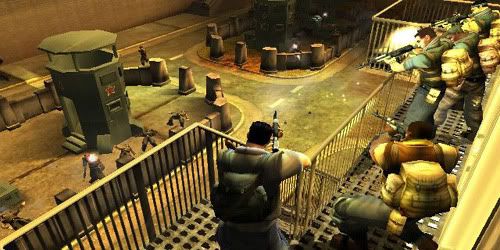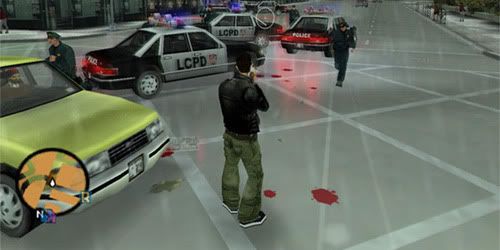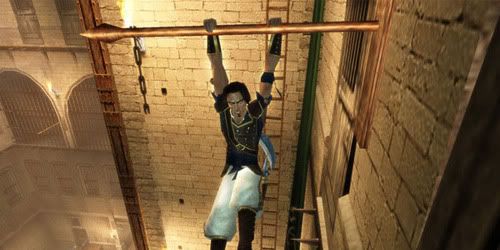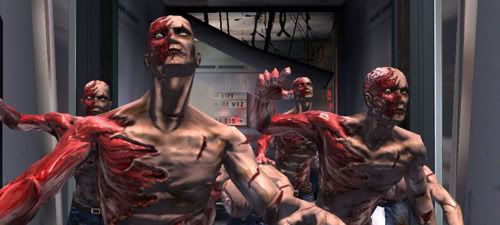Remember when I posted part one of two of an essay on Mirror's Edge? That's okay, I'm pretty sure no one else does either.

The inclusion of a story at all in Mirror's Edge feels a bit unnecessary and problematic; especially in its execution, flabby and perfunctory, it makes the game feel like any other unimpressive video game, plot and cutscenes tacked on because they're expected but not with any real effort put into them.
Yet the idea itself, of an underground struggle against a corporate police state, fits well thematically for a game whose central inspiration is free running. It seems an appropriate marriage of plot and mechanic, of story and mechanic, in the traditional sense of those terms, both using the theme of freedom and oppression.

It's a tall order, though, to make a game about freedom. Plenty of games have had a "fight for freedom" as their plot--any World War II game, usually; Freedom Fighters, of course; and so many others--but most of the time the plot is, again, perfunctory, an afterthought, and therefore no one expects any actual connection between that plot theme and the gameplay. In Mirror's Edge, though, the connection is much more explicit. A promise is, in some way, being made: as much as this is a game about flow, it is a game about freedom. And, as much as it fails to actually flow, and for much of the same reasons, the game fails to actually be free.
On the large-scale structural level, the game's linear and fixed series of levels, coupled with linear and fixed plot advancement, clearly doesn't even have a pretense of player freedom. On that level the game is a movie, just like so many other games: there are characters, they talk to each other in shitty movie dialogue, they fight or run or die, and players get to watch, without any choice or influence.
But this could be forgiven despite the game's promise of freedom if the game offered freedom on a smaller scale, the scale of the gamespace of the levels and the mechanics themselves--that's the more important part of the game, obviously, and what has much more impact on the thematic effect of a game. But of course there isn't any more freedom on this level, either: most sequences have one or at most two or three paths through them, with one branch or another offering little to no impact on future gameplay, and in the constant adrenaline rush pace of the game you don't have the opportunity to think much about your options anyway.

The obvious contrary here is to open world games like Grand Theft Auto or, well, pretty much any game from the past two years, as open world is currently quite in vogue. Mirror's Edge would actually make sense as an open world game, though, giving players something closer to the actual experience of free running, which is as much about breaking social norms, experimentation, and finding new ways to move as it is about looking cool. Mirror's Edge allows the player to do none of these, in fact enforces the opposite of this: you must follow the rigid, strict path set by the developers, or you fail. Experimentation is punished, not rewarded. You are not free.
But even if Mirror's Edge had been an open world game, wandering around the rooftops of the city Crashdown-style and taking conflicting missions from various characters, there would still be the mechanics themselves, conventional--nowadays perhaps even better referred to as old-school--platformer mechanics that are brutally strict, with very little valence between "successful jump" and "death". Higher jumps, true, have a further dimension of whether you successfully roll with the landing, thereby avoiding damage and keeping your momentum, or simply hit the ground hard, leaving yourself limping; but this is still just another aspect of "right" or "wrong", "succeed" or "fail", binaries of morality/efficiency that are antithetical to any discourse of freedom.
If Mirror's Edge, or any game, wants to truly be about freedom, its base mechanics need to reflect that, and that means more results than simply variances on a scale of positive to negative. That means that even the solutions of its platforming near-contemporaries--time reversal, quickload, etc.--would be just as ineffective: they might be more forgiving of mistakes, but they still enforce a strict difference between mistakes and the "right way" to play the game.

What's needed, really, are mechanics in which the different results of player choices are not merely "better" or "worse" ways of playing, not mechanics that can be optimized to achieve the most efficient completion. I'm not talking the "morality scale" endemic to (Western) RPGs, either, as that's just another binary system that confines players to developer expectations. Rather I'm talking about something like Sim City, something that's more toy than game, where rather than a structured game with set goals and win conditions the player is presented with a model of a world and a set of ways to interact with that model and then set loose to do what they will.
You can still have "better" and "worse" choices within particular subsystems--that is, you can still have ways that make your city poor or rich, or jumps that lead to your death--but the point is that navigating those subsystems is not the core of the game. They are important, sure, but only in that you have to understand how to navigate those systems in order to achieve your own goals, decided by yourself, and that those goals determine what systems you need to understand, and how you need to use them.
I realize that this sounds very, very far from the conception of Mirror's Edge. And in some ways it is--but not in the important ways, I think. This could still be a game based on free running--and now it would be a game that is actually about free running, about freedom and experimentation and defying expectations and making your own discoveries, rather than just another linear platformer with an unfulfilled promise of something better.






